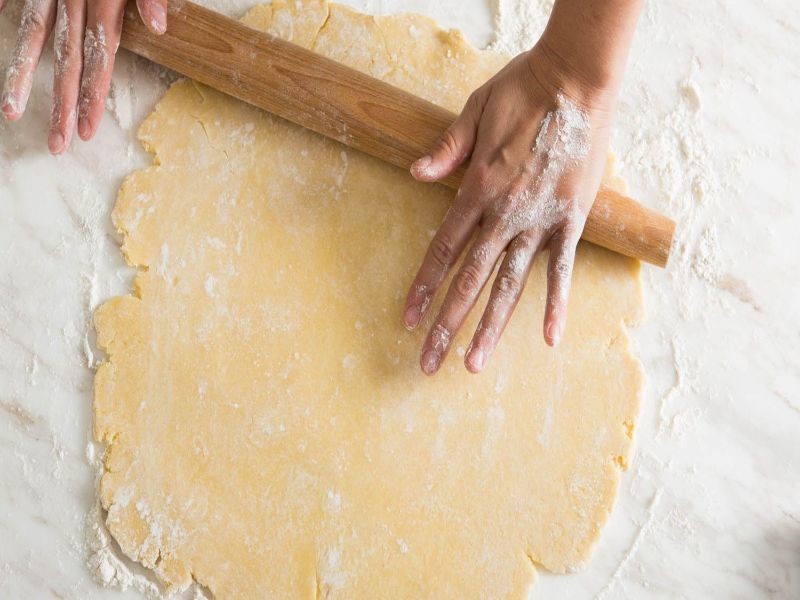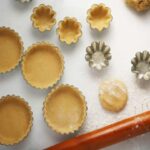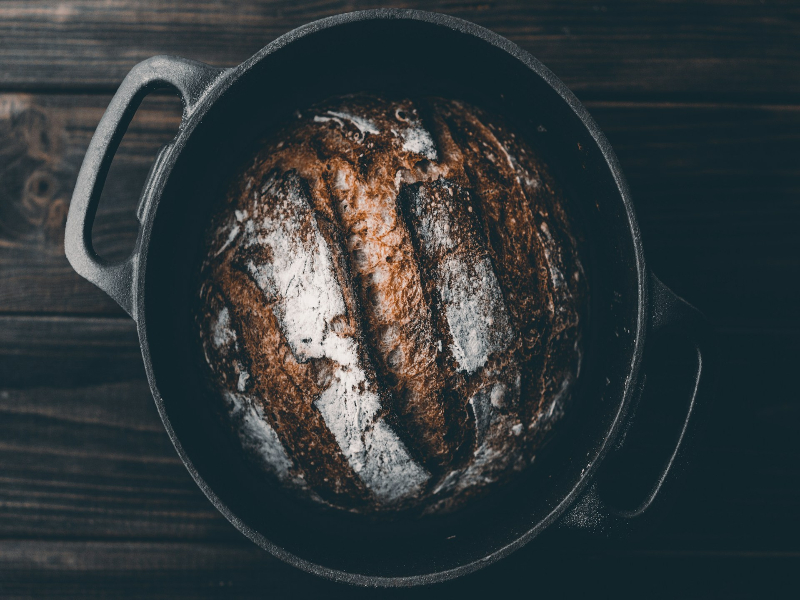
As American as…
Could it be the nation that invented pie as a dessert is edging towards homemade pie dough becoming a thing of the past?
Last week in a column in The Washington Post, Megan McArdle asked, “Can America save its national dish? Americans invented the dish we call pie. Why are we letting it die?”
I’ve been thinking about this a lot; asking practically everyone I’ve seen since reading her column their thoughts. At the 4th of July party, five of us wandered down memory lane sharing pie making stories, kinds of crusts and favorite fillings. So far that’s five still making the dough. Yesterday, I added another one to the homemade column with a friend whose grandmothers taught her well. She’s lucky enough to have a rolling pin from one grandmother she lovingly uses.
How about you? Did you grow up in a family where pie making was a tradition, with recipes passed down? Or are you one of the more than 50 million Americans who each year use frozen pie crusts and more than 40 million who use the refrigerated kind? Do I need smelling salts for your answer?
My mom was an amazing and creative cook, but she wasn’t a big believer in desserts or sugar so she wasn’t my pie crust teacher. Her thinking skipped a generation with me.
Crust making used to instill fear in me and my initial dough attempts were failures. Using two knives, a pastry cutter or food processor, I tried them all. My solution was to take a pie class. Turns out I wasn’t alone in my struggle and yes, practice does indeed make perfect. While I learned to do it by hand, I use a food processor.
I asked two of our chefs – Rocco DiGrazia and Aaron Manuyag – their go to. Chef Rocco of Rocco’s Little Chicago said full lard “for the win” and Chef Aaron, executive pastry chef at Loews Ventana Canyon Resort, opts for all butter with a touch of vinegar.
You know Chef Rocco for his award-winning pizza, wings and witty sayings on his marquee sign. On July 30 he’s showcasing his roots with an in-person and Zoom class: A Sicilian Summer Dinner, with dishes you won’t find on his menu. The stunning Urban Grove is the alfresco in-person setting. Summer Caponata Bruschetta, bursting with eggplant, vegetables and seasonings, jam-packed with flavors sweet, sour and salty is the appetizer. Busiate with Pesto Alla Trapanese is the pasta dish highlighting Sicily’s version of pesto with basil, mint, garlic, Parmesan cheese and almonds.
Grilled swordfish stuffed with pine nuts, golden raisins, Romano cheese and breadcrumbs is the main course. Since Sicilians and Tucsonans share a love of foods made with prickly pear fruit, Prickly Pear (fichi d’india) and Lemon Granita, a Sicilian ice dessert similar to sorbet, is a winning flavor combination that’s as appealing to the eye as to the palate, and the perfect way to end a summer meal.
This is our monthly Tucson Originals series. Just 14 seats remain for in-person so click here to register before you miss out or click here for the live Zoom version.
Want to bake with a Food Network star? Then join Chef Aaron on July 31 at the Urban Grove and on Zoom for All About Choux. Part of our Baking Fundamentals series, this workshop is hands-on, technique driven and more in-depth than our regular classes. Fresh off his five-week stint on the “Best Baker in America” competition, Chef Aaron was one of just 10 chefs selected as the best of the best.
Pâte à choux is the most versatile dough in pastry since it can be used both sweet and savory. Chef Aaron will turn you into an expert and give us the scoop of being on the series. Did you know there are no clocks in the TV kitchen but the bakers are periodically given how much time remains? In one episode the power went out and Chef Aaron was seen running down a hallway searching for a working oven. He’ll fill you in on all the details.
Showcasing its versatility, you’ll learn the art of this egg-based dough, how to tell when you achieve the perfect texture and confidently pipe cream puffs, churros, French cruller donuts and savory gougères. With Chef Aaron guiding you step-by step, you’ll pipe, make the cream and fill the puffs, fry and dust churros in cinnamon sugar, fry and hand dip crullers and pipe the gougères. There will be plenty for you to eat and take home.
To give you lots of personalized attention, in-person enrollment is limited to 16 and if you join us via Zoom, Chef Aaron will give you plenty of attention, too.
Wishing you joy in the kitchen,
Michele
 Julia Child’s Pâte Sablée – Sweet Pastry Crust
Julia Child’s Pâte Sablée – Sweet Pastry Crust
She used the scoop-and-level method of measuring flour. A chart in her “Mastering the Art of French Cooking” book gives the equivalent of 1 cup of flour as 5 ounces or 140 grams. Depending on the method of measuring and other factors such as the type of flour and humidity, flour can weigh from 4 to 5 ½ ounces per cup.
1 1/3 cups (182 g) all-purpose flour
3 tablespoons (38 g) granulated sugar
1/8 teaspoon baking powder
5 tablespoons (71 g) unsalted butter, chilled
2 tablespoons (28 g) vegetable shortening, chilled
1 egg, beaten with 1 tsp. ice water
½ teaspoons vanilla extract
To mix dough by hand:
1. Place flour, sugar and baking powder in a bowl and lightly mix to combine.
2. Cut chilled butter and shortening into ½-inch cubes and add to the dry ingredients. Using your fingertips, quickly rub together until the fat is broken into pea size bits.
3. Gently blend in the egg and vanilla, kneading dough into a ball.
To mix dough in a food processor:
1. Place flour, sugar and baking powder into the process bowl fitted with the metal blade and pulse once or twice to combine.
2. Cut chilled butter and shortening into ½-inch cubes. Add the butter to the bowl and pulse several times until the fat is broken into bits the size of peas.
3. Add the egg and vanilla, pulsing several more times just until the dough begins to mass on the blade. Be careful not to overmix.
Fraisage:
By smearing the dough after you’ve mixed it you elongate the pieces of butter. Instead of pieces or balls, you end up with streaks of butter throughout the dough. It also helps incorporate all ingredients homogeneously and brings it together in a soft, smooth dough.
1. With the heel of your hand, press the dough by two-spoonful bits at a time down on the board and away from you in a firm, quick smear of about 6 inches. Form the dough into a ball, wrap in waxed paper and chill for several hours until firm.
Rolling out the dough:
1. Let the chilled dough rest on the counter for 10 minutes to soften slightly.
2. Roll out on a lightly floured smooth surface or between two sheets of wax or parchment paper to prevent sticking.
Transferring dough to tart pan:
1. Carefully remove the top layer of wax or parchment paper and invert the disc of dough into the pan. Remove the other piece of paper and gently press the crust into the shape of the pan. Any cracks or holes can be patched with excess dough or by pressing the edges together.
2. Trim the edges by rolling a rolling pin on top of the pan or by trimming with a knife along the edge of the pan.
3. Chill crust before baking. I put it in the freezer for 30-60 minutes.
Baking the crust:
1. Preheat the oven to 375° F.
2. Line dough with parchment paper or foil and will the inside with pie weights, beans or rice and bake until the edges just begin to brown. The time will vary depending on the size of the tart pans used, the material the pans are made of and the varying heat of individual ovens. This could take approximately 10-20 minutes.
3. Remove the pie weights, prick the bottom of the tart with a fork in several places and continue baking the tart crust a few more minutes until the center is golden.
Notes: For small tartlets, it’s easier to form the dough into small balls and then roll the dough out into little circles on a floured surface. Alternatively, the small balls can be pressed by hand into the tartlet shell.
When lining and filling small tartlets with parchment/foil and weights, a trick is to press another tartlet tin on top of the crust to hold its shape during freezing and baking, eliminating the need to line the shells with parchment/foil and filling with weights.
Unrolled dough can be stored in the refrigerator for 2-3 days and about a month in the freezer. Baked pastry shells can be stored in an airtight container for several days or in the freezer for about a month before filling and using.
Photo credits: Vicky Wasik and Foodtasia





